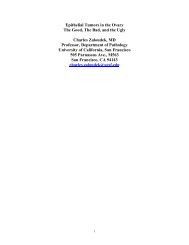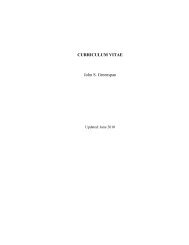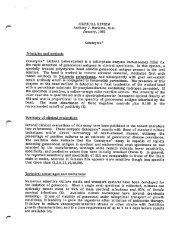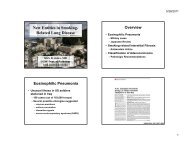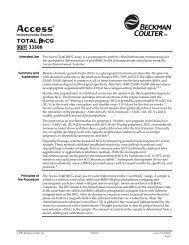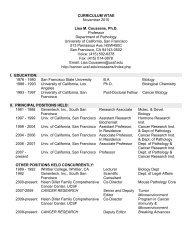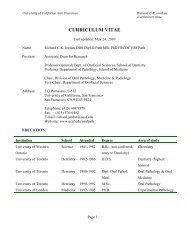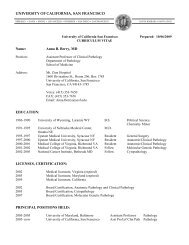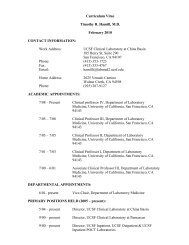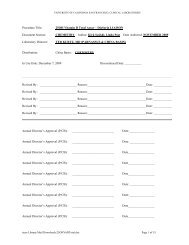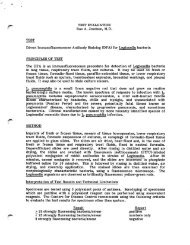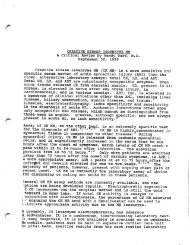Immunological Assay of CKMB
Immunological Assay of CKMB
Immunological Assay of CKMB
You also want an ePaper? Increase the reach of your titles
YUMPU automatically turns print PDFs into web optimized ePapers that Google loves.
TEST<br />
<strong>Immunological</strong> <strong>Assay</strong> <strong>of</strong> <strong>CKMB</strong><br />
THEORETICAL CONSIDERATIONS<br />
TEST EVALUATION<br />
Sara Bodner, M.D.<br />
A combination <strong>of</strong> creatine kinase (CK) and lactate dehydrogenase isoenzymes<br />
provide the best laboratory indication <strong>of</strong> myocardial infarction, and the classic<br />
method <strong>of</strong> determining these isoenzymes is electrophoresis (1). Recently developed<br />
immunologic assays for these isoenzymes are quicker and less expensive than<br />
electrophoresis (2). One such assay is an immunochemical method for <strong>CKMB</strong><br />
determinations combining an immunoinhibition step with a immunoprecipitation step<br />
(3).<br />
Creatine kinase (CK), found in high concentrations in muscle, catalyzes the<br />
phosphorylation <strong>of</strong> ADP from phosphocreatine, creating ATP and creatine (Fig. 1).<br />
Phosphocreatine is an energy storage form in muscle and creatine kinase (CK)<br />
catalyzes the rapid replenishment <strong>of</strong> ATP from phosphocreatine for use in muscle<br />
contraction. In serum, CK activity consists <strong>of</strong> at least 4 different isoenzymes, as<br />
well as a cross reactive enzyme, adenylate kinase, and other miscellaneous CK<br />
activities (Fig. 2). Structurally, CK is a dimer and 3 forms <strong>of</strong> the enzyme consist <strong>of</strong><br />
3 combinations <strong>of</strong> a "M" and a "B" monomer, CKMM, <strong>CKMB</strong>, and CKBB. Other CK<br />
activities include a mitochondrial CK, and a complex containing CKBB and<br />
immunoglobin. Creatine kinase MM is the predominent form in heart and skeletal<br />
muscle, although <strong>CKMB</strong> is found in substantial quantities in cardiac muscle.<br />
Creatine kinase BB is found in the brain, bladder, GI tract, and neonatal serum (4).<br />
The distribution <strong>of</strong> isoenzymes in tissues is shown (Table 1). Creatine kinase MB<br />
isoenzyme appears in serum 4 to 6 hours after an infarction, reaches a maximum at<br />
18 to 24 hours, and gradually declines to baseline levels at 48 to 72 hours post<br />
infarction (4). Total CK activity may be used in the estimation <strong>of</strong> the size <strong>of</strong> an<br />
infarction.<br />
Total CK activity in serum may be measured using NADH disappearance (340 nm) or<br />
the liberation <strong>of</strong> phosphate at a quantifiable endpoint. If, however, certain <strong>of</strong> the<br />
isoenzymes are removed from serum the remaining CK activity reflects only those<br />
isoenzymes which have not been inactivated, removed, or destroyed. Specific CK<br />
isoenzyme activity may be destroyed in 2 ways, immunoinhibition, or<br />
immunoprecipitation. In immunoinhibition, antibody directed against the CKM<br />
monomer inhibits all CKMM activity, one half <strong>of</strong> the <strong>CKMB</strong> activity, and none <strong>of</strong><br />
the CKBB, mitochondrial CK, adenylate kinase, or other CK activity (Fig. 3,<br />
Step II). In immunoprecipitation anti-CK-M-monomer-antibody, followed by anti-<br />
Fc-segment-antibody cause CKMM and <strong>CKMB</strong> to precipitate out <strong>of</strong> solution (Fig. 3,<br />
Step HI). The basis <strong>of</strong> the "immunochemical" method <strong>of</strong> <strong>CKMB</strong> determination is the<br />
subtraction <strong>of</strong> activity remaining after immunoprecipitation from the activity<br />
remaining after immunoinhibition (Fig. 3, Step IV). This assay is a substantial<br />
improvement over previous assays which employed only an immunoinhibition step<br />
(5-7,10), thus erroneously including CKBB and adenylate kinase activity in the<br />
measurement <strong>of</strong> <strong>CKMB</strong>.
00&*^<br />
JfjP^v<br />
CLINICAL APPLICATIONS<br />
Page 2<br />
Creatine kinase (CK) isoenzyme determinations have a major impact upon the<br />
diagnosis <strong>of</strong> myocardial infarction, and several studies have been done to determine<br />
whether immunochemical methods are as sensitive, specific, and efficient as<br />
electrophoresis in making this diagnosis (Table 2) (5-7). The standard against which<br />
these tests were compared were multiparameter laboratory determinations<br />
combined with clinical information, and assessed by a panel <strong>of</strong> experts. While these<br />
studies were imperfect (e.g., lacking a "gold" standard <strong>of</strong> diagnosis, and occasionally<br />
using electrophoretic CK and LDH determinations to establish the diagnosis) they<br />
indicate that the newer immunochemical method is as useful clinically in the<br />
diagnosis <strong>of</strong> myocardial infarction as electrophoresis. One study also demonstrates<br />
a 94.4% agreement between <strong>CKMB</strong> immunochemical and electrophoretic<br />
determinations. Because the CK immunochemical assay performs as well as the<br />
more expensive, more time-consuming electrophoretic method, it is gaining<br />
increased acceptance among pathologists and clinicians (2,8).<br />
Alternative methods for measuring CK isoenzymes include column chromatography,<br />
and radioimmunoassay. Column chromatography is even more time-consuming than<br />
electrophoresis and does not always adequately resolve CKMM, <strong>CKMB</strong>, and CKBB.<br />
The radioimmunoassay is very sensitive, but expensive, and exposes personnel to the<br />
hazards <strong>of</strong> radiation (12).<br />
TECHNICAL CONSIDERATIONS<br />
Most methods presently in use for total CK determinations may be adapted for use<br />
in <strong>CKMB</strong> immunochemical determinations. Serum pretreated with antibody and<br />
centrifugation as outlined in the immunochemical assay (Fig. 3) may be run in the<br />
same way as a total CK, and with a simple arithmetic computation the <strong>CKMB</strong> result<br />
can be calculated (R <strong>CKMB</strong> =2X (tube 2 - tube 1) (Fig. 3). Since 2 measured CK<br />
activities are being subtracted, a sensitive spectrophotometer must be used for<br />
h!fh.est accuraey- The small quantities resulting after subtraction may also create<br />
difficulties in precision and accuracy in the lower range <strong>of</strong> normal. Finally, some<br />
reagents used in total CK determinations are not compatible with substrates and<br />
reagents presently being used in the immunochemical assay. For example: the only<br />
immunochemical <strong>CKMB</strong> assay now on the market is produced by Roche. It is<br />
compatible with their (Roche) reagents for total CK determinations. Beckman's<br />
assay for total CK using the enzyme module on the Astra is also compatible with the<br />
(Roche) immunochemical assay for <strong>CKMB</strong>. On the other hand, KDA's reagents for<br />
total CK determinations result in imprecise results when combined with the (Roche)<br />
immunochemical assay for <strong>CKMB</strong> (13). To ensure highest precision and accuracy,<br />
the appropriate methods for CK determinations and sensitive spectrophotometers<br />
must be used.<br />
CONCLUSION<br />
For many years the gold standard in the diagnosis <strong>of</strong> acute myocardial infarction has<br />
been the combination <strong>of</strong> CK and LDH isoenzyme electrophoresis. Recently<br />
f developed immunochemical methods have demonstrated sensitivity, specificity,
*PpSs>\<br />
yfP**^<br />
Page 3<br />
efficiency, and predictive values comparable to those <strong>of</strong> electrophoresis in clinical<br />
trials. These immunochemical methods are also less time-consuming and less<br />
expensive than electrophoretic methods. Because <strong>of</strong> the economic pressures on<br />
medical care it appears likely that immunochemical methods will at least undergo<br />
further scrutiny, and possibly in part supplant electrophoretic methods in the<br />
diagnosis <strong>of</strong> acute myocardial infarction.<br />
REFERENCES<br />
1. Galen RS, Ruffel JA, Gambino R. Diagnosis <strong>of</strong> acute myocardial infarction<br />
relative efficiency <strong>of</strong> serum enzyme and isoenzyme measurements. JAMA<br />
232(2), 1975.<br />
2. Wu AHB, Bowers GN. Evaluation and comparison <strong>of</strong> immunoinhibition and<br />
immunoprecipitation methods for differentiating MB from BB and macro forms<br />
<strong>of</strong> creatine kinase CK isoenzymes in patients and healthy individuals. Clin<br />
Chem 28:2017-2021, 1982.<br />
3. Wicks R, Usatequi-Gomez M, Miller M, Warshaw M. Immunochemical<br />
determination <strong>of</strong> CK-MB isoenzyme in serum. II. An enzymatic approach.<br />
Clin Chem 28(l):54-58, 1982.<br />
4. Pesa MA. The CK isoenzymes: findings and meanings. Laboratory<br />
Management, October, 1982.<br />
5. Ali M, Laraia S, Angeli R, Fayemi O, Braun EV, Davis E, Palladino PH.<br />
Immunochemical CK-MB assay for myocardial infarction. Am J Clin Pathol<br />
77(5):573-579, 1982.<br />
6. Seckinger DL, Vezquez A, Rosenthal PK, Mendizabal RC. Cardio isoenzyme<br />
methodology and the diagnosis <strong>of</strong> acute myocardial infarction. Am J Clin<br />
Pathol 80(2):164-169, 1983.<br />
7. Bruno DL, Chitwood J, Koller K, Hill KE, Mostrom J, Savoy J. Creatine<br />
kinase-MB activity: Clinical and laboratory studies <strong>of</strong> immunochemical<br />
technique with optimized enzymatic assay. Ann Clin Lab Sci 13(l):59-65.<br />
1983.<br />
8. Statland BE. CK isoenzymes. MLO, June 1982, pp 14-15.<br />
9. Galen RS. Tips on technology. MLO, September 1981, pp 13-14.<br />
10. Obzansky D, Lott JA. Clinical evaluation <strong>of</strong> an immunoinhibitor procedure for<br />
creatine kinase-MB. Clin Chem 26(1):150-152, 1980.<br />
11. Sobel BE, Brenahan GF, Shell WI, et al. Estimation <strong>of</strong> infarct size in man and<br />
its relation to prognosis. Circulation 46:640-648, 1972.<br />
12. Lott JA, Stung JM. Clin Chem 26:124-150, 1980.<br />
13. Personal communication. Technical representative. H<strong>of</strong>fman Roche, Inc.<br />
Nutley, New Jersey.
Table I. Distribution <strong>of</strong> CK and CK isoenzymes in Various Tissues<br />
Tissue Range <strong>of</strong><br />
Total CK<br />
(U/gm tissue)<br />
Range <strong>of</strong> CK Isoenzymes<br />
M M M B B B<br />
(%)<br />
Skeletal muscle 1080-3050 96-100 0-4 0<br />
Heart muscle 190-692 58-36 15-42 . 0-1<br />
Brain 73-200 0 0 100<br />
Bladder 162 2 6 92<br />
Placenta 250 19 1 80<br />
Gastrointestinal<br />
tract<br />
145 3-4 0-2 96<br />
Thyroid 32-34 4-79 0-6 15-96<br />
Uterus 9-38 2-20 2-20 60-96<br />
Kidney 10-18 10 0 90<br />
Lung 11-13 26-60 0-1 2-14<br />
Prostate 8-9 4-40 3-4 56-93<br />
Spleen 2-7 0-74 0 26-100<br />
Liver 3-4 0-90 0-6 4-100<br />
Pancreas 3 14 1 85
^ ) '")<br />
Table 2. Studies Comparing Electrophoretic and Immunochemical Methods<br />
in the Diagnosis <strong>of</strong> MI<br />
Ref/Method #Pts 3 Pts w/ MI Sensitivity Specificity PV(+) PV(-) Efficiency Precision<br />
(5)Ali 215 45<br />
Immunochemical Method 95.5 95.3 95.3<br />
Electrophoretic Method 93.3 94.7 94.4<br />
(6) Sukmger<br />
Immunochemical Method<br />
Electrophoretic Method<br />
(7) Bruns<br />
Immunochemical Method<br />
180 36<br />
99 27<br />
100<br />
88<br />
93 78<br />
79<br />
100 97 94 5 to 12%<br />
100<br />
94<br />
95<br />
89<br />
(u = 39)
1 "1 1<br />
Figure I.<br />
Creatinec,^<br />
P h o s p h o c r e a t i n e - | - A n p ^ ^ A T P + C r e a t i n e<br />
Kinase<br />
Figure II.<br />
CK^, • CKtilo , CK<br />
CK Total = olH/IM + UIVMB + olBB + CK(mitochondrial) + Adenylate Kinase<br />
+ O t h e r s
F Ijre III.<br />
ISOMUNE — CK PROCEDURE<br />
I. Add 200 |iI <strong>of</strong> patient's serum to each <strong>of</strong> two test tubes<br />
m<br />
qO AK<br />
OQ<br />
Tubel<br />
iQQl<br />
»O0<br />
Tubel<br />
AK<br />
qQ<br />
AK<br />
OB<br />
Tube 2 (Blank tube)<br />
Add 200 ul <strong>of</strong> solid phase<br />
anti-goat IgG, mix and<br />
incubate 5 min. at ambient<br />
temperature<br />
Tube 2 (Blank tube)<br />
Solid phase<br />
anti-goat IgG<br />
Anti-MM<br />
serum<br />
1.<br />
Add 250 ul <strong>of</strong> anti-MM serum,<br />
JL mix and incubate for 20 min.<br />
at ambient temperature<br />
/<br />
A<br />
anti-MM<br />
w.<br />
|Q0]<br />
Tubel<br />
AK<br />
1001 AK<br />
■ O g -<br />
QQ<br />
Tubel<br />
Add 50 ul <strong>of</strong> anti-MM serum,<br />
mix and incubate for 5 min.<br />
at ambient temperature<br />
AK<br />
Tube 2 (Blank tube)<br />
Centrifuge for 5 min. at 1000 x g<br />
Tube 2 (Blank tube)<br />
Subtract the enzyme activity in the supernate <strong>of</strong> the blank<br />
tube from that <strong>of</strong> tube 1
Figure II. Fibrinogen Degradation (22)<br />
Fibrinogen<br />
Plasmm<br />
Fibrinogen<br />
Degradation<br />
Products<br />
Thrombin<br />
Fibrin monomer<br />
and macromolecular complexes<br />
non-crosslinked Fibrin<br />
Monomer<br />
Plasmm<br />
non-crosslinked<br />
Fibrin Degradation<br />
Products<br />
Modified from Colman and Hirsch (page 155)<br />
xnia<br />
crosslmked Fibrin<br />
Plasmm<br />
crosslmked<br />
Fibrin Degradation<br />
Products



